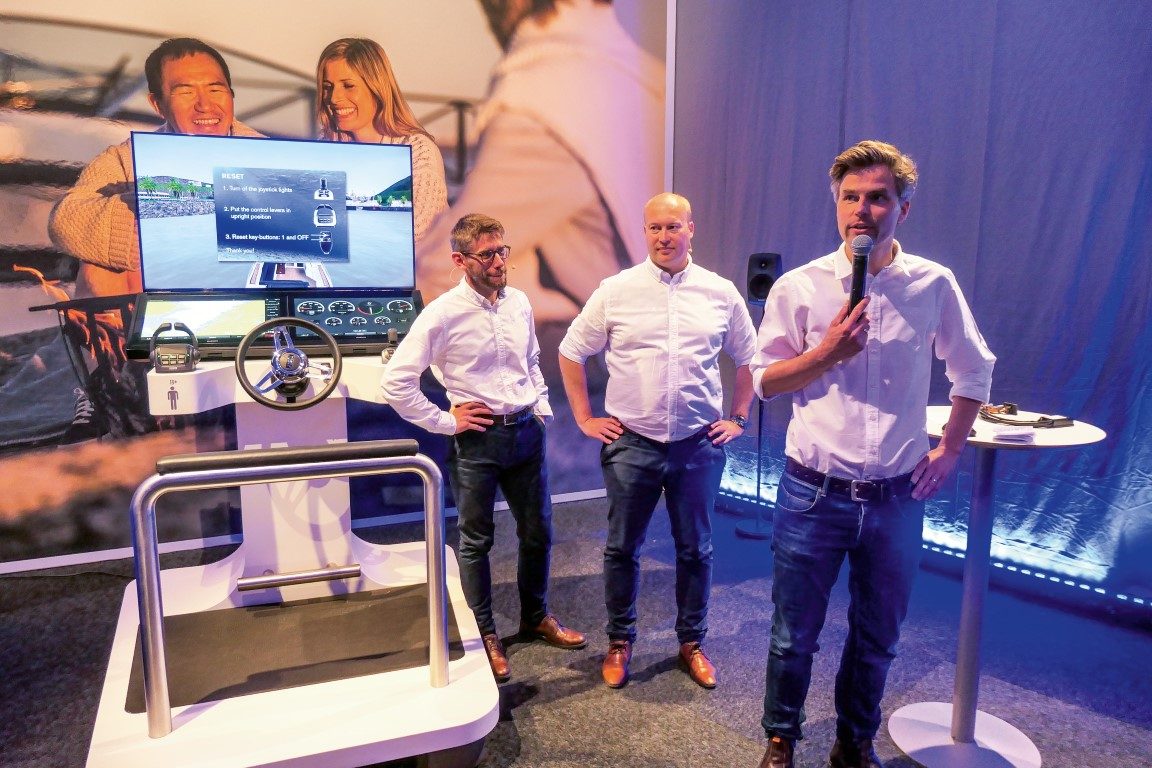

In a series of events catering to the international boating media, Volvo Penta recently unveiled a raft of new products at its Krossholmen testing site near Gothenburg, Sweden. John Eichelsheim was there.
Boating New Zealand attended one of the press days, travelling with other marine journalists in an electric Volvo bus from our hotel to the organisation’s high-tech R&D facility on the shores of the North Atlantic Ocean. During the course of a wet, stormy day, we were treated to series of indoor presentations detailing some of Volvo Penta’s latest releases for the marine market, followed by on-water demonstrations among the islands of the southern Göteborg Archipelago.
Making boating easier
Volvo Penta has always been an innovative company, introducing groundbreaking products like the Aquamatic sterndrive (1959), Duoprop sterndrive with counter-rotating propellers (1982), diesel engines with both supercharging and turbocharging (1991), petrol engines fitted exclusively with electronic fuel injection (1994), Electronic Vessel Control (EVC – 2003), Volvo Penta IPS (Inboard Performance System) forward-facing pod-drive propulsion (2005), joystick control (2006), Glass Cockpit system (2013), Forward Drive Duo-prop sterndrive (2015), E-Key remote (2016) and much more.
Its designers and engineers strive to deliver an integrated approach to boating, so that everything works in concert. Easier boating is the goal, which they aim to achieve by offering car-like solutions that are seamless, accessible and always available. The company already provides integration from the propeller to the helm, and the new products introduced to the media in Sweden expand on this theme. The future of Volvo Penta is: Automated, Connected, Electric.
New D4/D6
The D4 and D6 family of propulsion packages is among the company’s most successful, with over 100,000 produced since 2003. For 2019, the range gets a comprehensive helm-to-prop update that not only delivers more power and better reliability, but also cuts operating costs by up to a third.
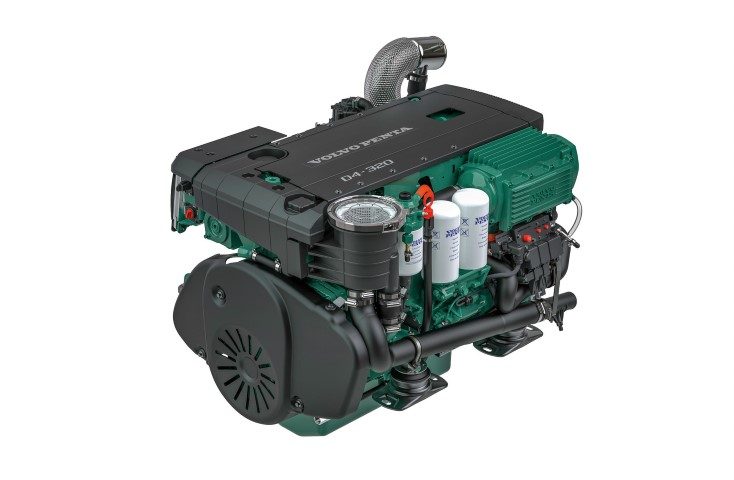
These next generation D4 and D6 packages are available in Volva Penta IPS, conventional inboard and Aquamatic sterndrive variants, each boasting a raft of improvements. The new units don’t look very different to the D4/D6 series they are replacing, with an identical footprint and only a slight difference in height for some variants, but almost every aspect of the fully-integrated system has been upgraded – 85% of the engines have been modified and refined.
Over 300,000 hours went into re-engineering the new generation D4/D6 family – that’s 50 Volvo Penta specialists working for three years – followed by 40,000 hours of testing – equivalent to travelling eight times around the world.
The engines have been re-engineered to deliver more power and torque – up to 320hp for the 3.7-litre, four-cylinder D4 and up to 480hp for the 5.5-litre, six-cylinder D6 – and even better fuel efficiency. All the engines feature intercooled turbocharging, with or without a compressor, and some also add supercharging. Engine upgrades include a new engine management system, new fuel injection system, new forced induction systems (new turbocharger and supercharger). Also new are the cylinder heads, pistons and valves, designed to cope with the engines’ increased performance, along with a stronger crankshaft. The new engines are smoother with better harmonics for an enhanced driving experience and all D4/D6 specifications are available in 12 or 24-volt configurations.

Owning the new D4/D6 packages will cost less as well, says Volvo, not only due to improved fuel efficiency (1-7%), but also because of longer service intervals and fewer service items. The company claims the new units will deliver 30% fewer unscheduled service disruptions. Taken together, these improvements add up to significant annual savings in fuel, parts and servicing.
Of course, with Volvo Penta the engines are just one part of a propulsion package that includes the driveline and Electronic Vessel Control (EVC) system. Both have been upgraded and enhanced.
The IPS driveline has seen improvements in durability and reliability while the DPI sterndrive has been considerably upgraded and improved (see below). Like IPS, the DPI driveline now comes with Dynamic Positioning System (DPS), which in twin-engine installations automatically maintains the boat’s position and heading, even in windy or high current situations. With DPS, docking becomes much easier.
Inboard versions of the D4/D6 are available for either shaft or waterjet installations.
The new engine packages also benefit from Volvo Penta’s new generation Electronic Vessel Control –EVC 2. It’s the first upgrade since 2003, with an all-new operating system, greater independence from the engine and expanded connectivity. EVC 2 provides more functionality, improved diagnostics and a large degree of future proofing. Read on for more details.
New drivelines
2019 upgrades to IPS have focused on easier servicing and greater reliability.
Introduced in 2005, IPS has forward-facing, twin counter-rotating propellers that sit below the hull for remarkable ‘grip’ of the water. With individual steerable pods controlled by a joystick, compared to a conventional inboard shaft installation, the IPS system provides superior handling and manoeuvrability, up to 15% faster acceleration and 20% higher top speeds, as much as 30% lower fuel consumption and less noise and vibration.
For 2019, Volvo Penta has made it easier to monitor and service the IPS system. Filters and oil can now be accessed from inside the hull and the oil only needs changing every second year, during which the boat can stay in the water. Sensors have been added to immediately identify clogged filters and water in the oil.
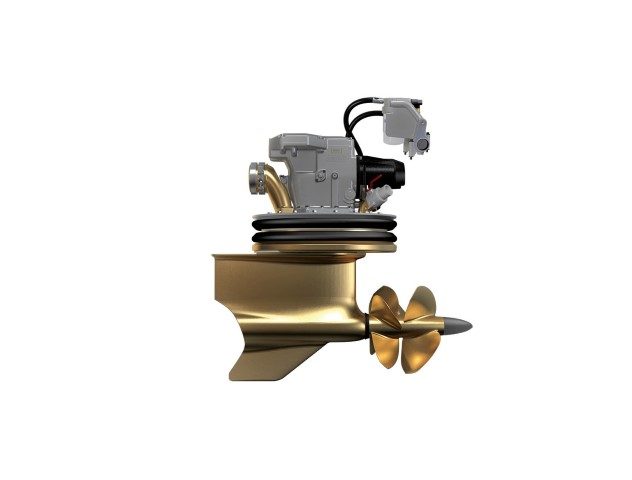
Gear material has been reinforced with high-strength steel, while the propeller shaft seal, input bearing carrier and upper shaft and bearings have all been redesigned to improve durability. All IPS and DPI units are assembled in a new “clean room” to provide longer operational life and improved reliability.
Improvements to the Aquamatic DPI sterndrive include a new hydraulic clutch that affords silent, silky-smooth shifting, attributes that were immediately obvious during our field testing at Krossholmen. The new clutch also allows ‘slipping’ at low engine revolutions, for better control and slower boat speeds in close quarters situations.
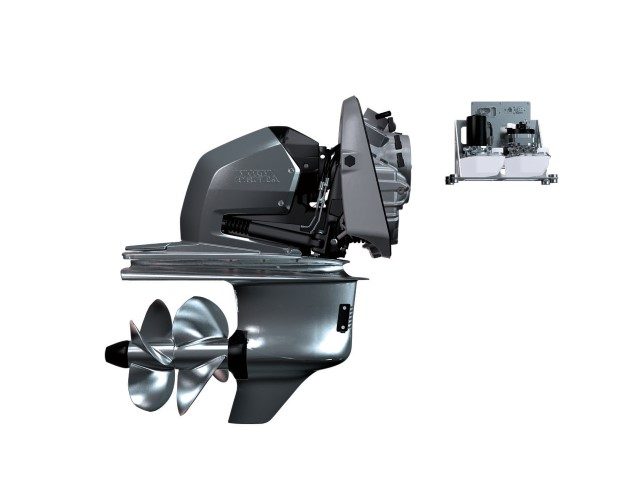
Electric steering is now standard, which when combined with the hydraulic clutch in twin sterndrive configurations, enables joystick docking as well as Dynamic Positioning System functionality.
Reliability has been further enhanced with redesigned and reinforced components, clean room assembly and additional sensors for better driveline health monitoring and improved diagnostics. DPI can handle D6 power up to 440hp.
Further ownership benefits include longer service intervals, fewer service items and seals designed for longer life. Instead of annual oil and filter changes they are now required only every two years.
EVC 2
Easy boating is front and centre with EVC 2, designed with the complete vessel in mind.
Volvo Penta’s EVC system connects and manages the internal communications between the engine and driveline, levers and display screen. Since its introduction in 2003, the aim has been to give vessel owners integrated functionality and simpler operation. Over time, EVC has integrated introductions such as Joystick Docking, Dynamic Positioning System and Glass Cockpit to make the boating experience easier and more accessible.
With EVC 2, the system gets a major update. A new electrical architecture ensures faster software downloads, improved diagnostics and traceability, as well as offering the ability to integrate additional functionality in the future. A new satin-grey joystick and control lever updates the system visually.
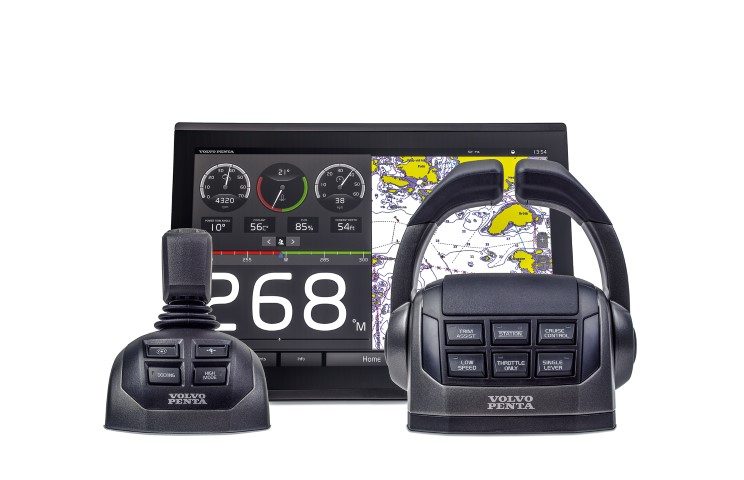
The EVC is the electrical platform that controls the vessel’s functionality and features, including the engine and driveline. EVC 2 is now more independent of the driveline, to better prepare it for the future when it will act as the primary enabler. It will form the foundation for connecting all future features in a boat and allow new services to be uploaded anywhere in the world, as and when automated, connected and electric features become available. EVC 2 allows more features to be connected into the ecosystem of the vessel, giving builders more flexibility when building a boat.
Key new features include On-Board Maintenance Assist, which keeps track of past servicing, diagnostic data and upcoming service dates. Electronic steering on single and twin DPI installations eliminates hydraulic fluid at the helm and makes available Low Speed and DPS functions. And regardless of the number of engines, the new platform only has a single connection point, so it benefits from faster software downloads and enhanced diagnostics. Maintenance is also easier.
On the water
It might have been summer in Sweden, but conditions on the water at Krossholmen were not the best for my group’s demonstrations. But despite horizontal rain and 40-knot wind gusts, we managed to try all the new engines, drivelines and EVC 2 systems in vessels ranging from 11 to 14.4m.
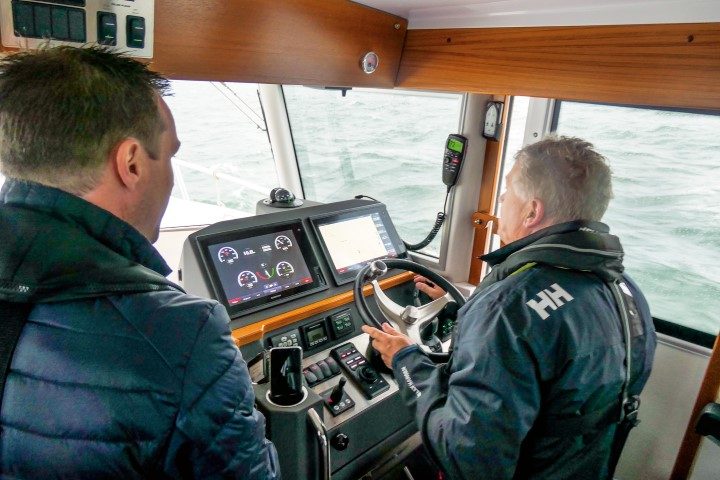
It’s hard to make any useful observations about the engines, except to note that some of the boats performed very well with twin D4-320hp power when I might have expected D6s, while the larger vessels in the demonstration performed equally well with a pair of 480hp D6 engines. The increase in horsepower across the range clearly offers boatbuilders more flexibility when it comes to choosing Volvo Penta power.
As far as the many improvements and enhancements to the engines and drivetrains go, most of them are hidden and their real benefits will only become apparent over time.
What was immediately detectable was the difference the hydraulic clutch makes to shifting gears aboard those boats fitted with DPI drivelines. Shifts were extremely smooth – clunking is a thing of the past – and the Low Speed functionality is definitely a great addition.
Impressive too is the Dynamic Positioning System, which I used to hold the Sargo 33 fitted with twin D4-320s on the spot in windy conditions. DPS was also able to bring the boat back to the precise spot at which DPS was engaged, before holding it in place by automatically manipulating throttle and drives.
Twin DPIs also allow joystick control, which I found to be very precise. The boats equipped with DPI drivetrains were perhaps not quite as manoeuvrable in the windy conditions as those fitted with IPS, but they were still very good. It was possible to move the boats sideways or slide them between other vessels into a tight dock.
Assisted docking
The final demonstration for the day, illustrating Volvo Penta’s dedication to seamlessly integrating vessel systems, was ‘Assisted Manoeuvring’. First demonstrated in Gothenburg last year during the Volvo Ocean Race, it’s a system still under development that integrates a whole suite of Volvo technology to park the boat. To all intents and purposes, the vessel parks itself.
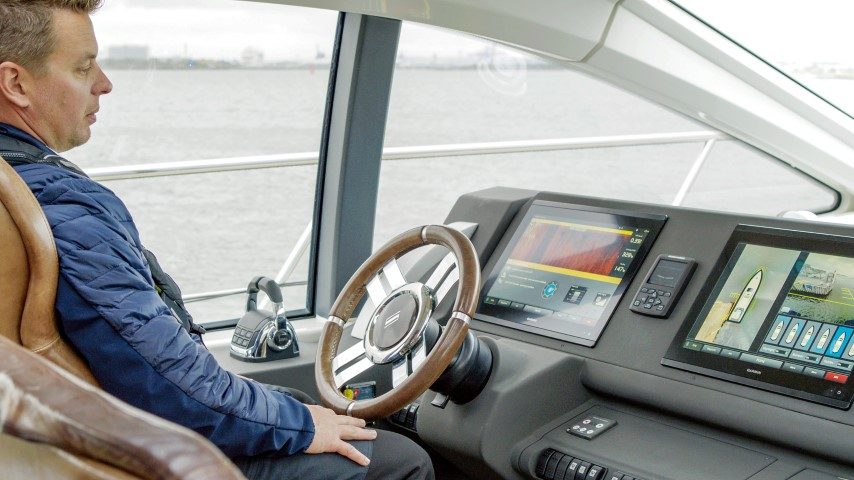
Volvo Penta demonstrated just how far it has come by repeatedly parking an IPS-equipped, 62-foot Azimut, letting the technology do all the work. In every case the system parked the boat perfectly in a totally controlled manner, despite strong crosswinds.
It was very impressive and is something to look out for in the future.




